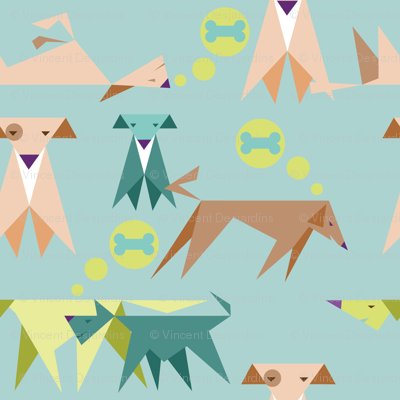The Day my Dog became a Triangle
Dogs are not triangles. Any fool knows this. They don’t even bother assessing this knowledge when they issue you with a dog license. So it was very awkward indeed when my dog became a triangle. For a start her name is Chloe. This is less embarrassing to call out at our local dog park compared to “Pythagoras”, even if people called Chloe do get offended when I point out it is a dog’s name. Equilateral would be a very inappropriate name for a Welsh Springer Spaniel. Scalene sounds like a skin disease or a song by Dolly Parton. Isosceles, well now we are getting just a tad pretentious.
 Now you might be wondering why my dog became a triangle. Did she decide one day that our social construction of welsh springer spaniels was way too limiting for this pooch? Had I been at the green chartreuse again? The answer is simpler and more complex at the same time. I decided it was time to have a look around me. And I mean really look. To look at things in a way I’d never looked at things before.
Now you might be wondering why my dog became a triangle. Did she decide one day that our social construction of welsh springer spaniels was way too limiting for this pooch? Had I been at the green chartreuse again? The answer is simpler and more complex at the same time. I decided it was time to have a look around me. And I mean really look. To look at things in a way I’d never looked at things before.
Looking at things newly is a lot harder than it sounds. Try telling someone to look at things differently and generally all they will do is look at you in a very familiar and unoriginal questioning manner. Or they will punch you in the face. Or both.
The trick is give yourself or another some parameters. Some limits. Presumably you are reading this blog on some form of screen. Look at the screen and everything around you in only one of the following ways:
- as a series of circles
- as blotches of color
- as a series of triangles
- as a swatch of textures
- as a stormy sea
- as a part of a basketball
- as the head of a flower
- from the front and the side at the same time
 How did you go? Could you manage it? Could you draw what you saw? For those who managed successfully, you have very probably been creative. Who knows some might even have been Creative (little c creative is what I term small personal wins, amusements or provocations. Little nudges that prompt our thinking. Big C creative is the type that Csikzentmihalyi (1996) sees as solving a problem in a new and useful way that is recognized by others.
How did you go? Could you manage it? Could you draw what you saw? For those who managed successfully, you have very probably been creative. Who knows some might even have been Creative (little c creative is what I term small personal wins, amusements or provocations. Little nudges that prompt our thinking. Big C creative is the type that Csikzentmihalyi (1996) sees as solving a problem in a new and useful way that is recognized by others.
We could try the same exercise using poetry. Stephen Fry in the Ode Less Travelled, points out that the limitation of Iambic Pentameter (having five feet to each line of verse followjng a “tee-tum, tee-tum, tee-tum, tee-tum, tee-tum” structure) actually fosters creativity as one has to fit meaning into this structure. For instance, he cites Shakespeare’s Sonnet 73
“That time of year; thou mayst in me behold
When yellow leaves, or none, or few, do hang”
As Fry points out, it is the limitations that we impose on our attempts at expression and the tension that these create that often lead to great creative expression “Painters paint within a canvas, composers within a structure. It is often the feeling of the human spirit trying to break free of constrictions that gives art its power and its correspondence to our lives, hedged in as ours are by laws and restrictions” (p24).
The idea of Creativity arising from constraints is commonly understood in creative circles and those that study creativity (e.g. Stokes, Creativity from Constraints, 2006). Related to this idea is US painter and jazz musician Larry Rivers, who used a musical metaphor in describing the material we use for the basis of our creativity as the “first chorus”.
I love the idea of the first chorus. In jazz, the first chorus is often played “straight” to give the audience the structure of the piece, and from there the musicians can improvise (though like Fry’s poetry the improvisation is limited by the chords and chord changes).
The idea of the first chorus is the point at which one has mastered some domain, become familiar or expert. Rivers says that creativity is the variation on history – on all the stored ideas in ones memory. The first chorus is merely a repetition and is not creative. This is why experts often get bored because they master the first chorus and then are engaged to endlessly repeat it. They are interested in adding and combining – improvising – and therefore being creative. This fits well with my model of creativity, creative people want to go beyond mastery, hence the title for my model.
The importance of limitation to creativity is a valuable reminder that when working with individuals looking to change their lives, or looking to change our own, an important first step is to acknowledge the limitations. Then we we have something tangible to work with, something that allows us to be creative as we look for ways to improvise in our lives, to find solutions by combining the pieces we have or we can obtain, to get a new hand by shuffling the deck of cards we already have or could obtain.
It seems as though everything I am saying here about limitation goes against counseling injunctions to focus on strengths, or to be optimistic but that misses the point. A true understanding of strengths only comes in the context of knowledge of the limitations, optimism is most powerful when directed at the attainable. Nor does this mean we should overly encourage people to limit themselves, we should not. Too often people who are looking for solutions in their life are “stuck” (Amundson, 2007). However in unsticking other people or ourselves, getting people to improvise and strategize using the materials they have and those readily to hand around them is likely to result in more inventive, creative and positive solutions to their own problems than simply asking them to be more creative. Our limitations are our strengths.
As I’ve said before, each of us is like a beautiful song. We are limited by the melody and chord structures. However those limitations are the very things that give us our uniqueness, our identity. It is those limitations that allows us to strain against them by being creative in rearranging and improvising so our song can be played in an infinite number of ways. We cannot be anything we want to be, but there are an infinite number of ways of being us.
Often in counseling or coaching for change we encourage others to take a different perspective on a situation. Changing metaphors, re-writing the story, re-framing, reality checking, skills audits, values lists, interests are all examples of encouraging people to take a new look.
However what I am talking about is fundamentally deeper and that is to see something familiar, something mastered not from a different perspective, but through new eyes. To hold multiple stories at the same time, to have multiple metaphors simultaneously, to find new solutions using the materials of your history and what is readily available to you in terms of supports, resources, and ideas. Good career development gives you a new perspective. Great career development has you seeing differently.
Sadly for me and my thinking it didn’t stop with the triangular dog. The cat become a crescent, my kids become trapezoids, trees become oblongs. And this sentence became a full stop.
References
Amundson, N. (2007). Active Engagement 3rd Edition.BC. Canada Ergon Communications.
Csikzentmihalyi M. (1996). Creativity. Flow and the Psychology of Discovery and Invention. New York: Harper Perennial.
Fry, S. (2005). The Ode Less Travelled. London. Hutchinson.
Stokes. P. (2006). Creativity from Constraints. New York, NY. Springer.
Related Posts










Pingback: Career Coaching News from Bright and Associates Career Solutions May 2014 | The Factory